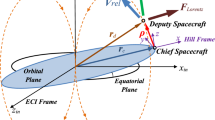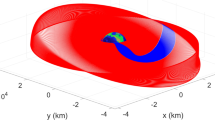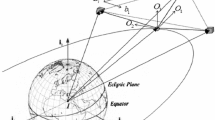Abstract
The electromagnetic force generated by the interaction of electromagnetic coils can be used to replace the conventional propellant consumption mode in close relative motion control, thereby promoting the application of formation flight technology for long-term and continuous space missions. Herein, a hysteresis-switching logic-based switching linear parameter varying (LPV) controller synthesis technique with guaranteed performance for electromagnetic formation flying on a highly elliptical orbit is proposed. First, considering that the relative dynamics model of an elliptical orbit is characterized by time-varying uncertainty, the LPV model is described. By introducing switching LPV controllers among different scheduled parameter subsets, conservativeness can be reduced. Second, the system modeling error, the uncertainty caused by a simplified electromagnetic coil model, and external disturbance are considered to derive switching LPV controller synthesis conditions based on the guaranteed H∞ performance. Derivation analysis shows that the proposed switching LPV controller not only ensures the robustness of the system against uncertainties, but also realizes the control input constraints. Finally, numerical simulations and comparative analyses are performed to demonstrate the effectiveness and advantages of the proposed control method.

Similar content being viewed by others
Change history
11 February 2022
A Correction to this paper has been published: https://doi.org/10.1007/s42064-022-0136-2
References
Miller, D. W., Sedwick, R. J., Kong, E. M. C., Schweighart, S. Electromagnetic formation flight for sparse aperture telescopes. In: Proceeding of the IEEE Aerospace Conference, 2002: 2.
Elias, L. M., Kwon, D. W., Sedwick, R. J., Miller, D. W. Electromagnetic formation flight dynamics including reaction wheel gyroscopic stiffening effects. Journal of Guidance, Control, and Dynamics, 2007, 30(2): 499–511.
Huang, H., Cai, W. W., Yang, L. P. 6-DOF formation keeping control for an invariant three-craft triangular electromagnetic formation. Advances in Space Research, 2020, 65(1): 312–325.
Miller, D. W., Ahsun, U., Ramirez-Riberos, J. L. Control of electromagnetic satellite formations in near-Earth orbits. Journal of Guidance, Control, and Dynamics, 2010, 33(6): 1883–1891.
Xu, Z., Shi, P., Zhao, Y. Adaptive control for two-spacecraft electromagnetic formation keeping. Journal of Beijing University of Aeronautics and Astronautics, 2015, 41(12): 2302–2308. (in Chinese)
Zeng, G. Q., Hu, M. Finite-time control for electromagnetic satellite formations. Acta Astronautica, 2012, 74: 120–130.
Huang, X. L., Zhang, C., Lu, H. Q., Li, M. M. Adaptive reaching law based sliding mode control for electromagnetic formation flight with input saturation. Journal of the Franklin Institute, 2016, 353(11): 2398–2417.
Zhang, Y., Shi, P., Zhang, H., Zhao, Y. A robust coordinated control method for hovering of electromagnetic spacecraft formation. Journal of Beijing University of Aeronautics and Astronautics, 2019, 45(2): 388–397. (in Chinese)
Sun, X. Z., Xia, D. W., Chen, W. D., Hao, Y., Mantey, K. A., Zhao, H. Dual quaternion based dynamics modeling for electromagnetic collocated satellites of diffraction imaging on geostationary orbit. Acta Astronautica, 2020, 166: 52–58.
Qi, D. W., Yang, L. P., Zhang, Y. W., Cai, W. W. Indirect robust suboptimal control of two-satellite electromagnetic formation reconfiguration with geomagnetic effect. Advances in Space Research, 2019, 64(11): 2331–2344.
Marcos, A., Penin, L., di Sotto, E., Drai, R. Formation flying control in highly elliptical orbits. In: Proceedings of the AIAA Guidance, Navigation and Control Conference and Exhibit, 2007: 2252–2265.
Wei, C. Z., Park, S. Y., Park, C. Optimal H∞ robust output feedback control for satellite formation in arbitrary elliptical reference orbits. Advances in Space Research, 2014, 54(6): 969–989.
Rugh, W. J., Shamma, J. S. Research on gain scheduling. Automatica, 2000, 36(10): 1401–1425.
Zhao, P. Robust and optimal switching linear parameter-varying control. Ph.D. Dissertation. Vancouver, Canada: University of British Columbia, 2018: 2–8.
Shamma, J. S., Cloutier, J. R. Gain-scheduled missile autopilot design using linear parameter varying transformations. Journal of Guidance, Control, and Dynamics, 1993, 16(2): 256–263.
El Ghaoui, L., Niculescu, S. L. Advances in Linear Matrix Inequality Methods in Control. SIAM Publication Online, 2000: 209–228.
Scherer, C., Gahinet, P., Chilali, M. Multiobjective output-feedback control via LMI optimization. IEEE Transactions on Automatic Control, 1997, 42(7): 896–911.
Apkarian, P., Adams, R. J. Advanced gain-scheduling techniques for uncertain systems. IEEE Transactions on Control Systems Technology, 1998, 6(1): 21–32.
He, T. Y., Al-Jiboory, A. K., Zhu, G. G., Swei, S. S. M., Su, W. H. Application of ICC LPV control to a blendedwing-body airplane with guaranteed H∞ performance. Aerospace Science and Technology, 2018, 81: 88–98.
Nie, L., Cai, B., Lu, S. G., Qin, H., Zhang, L. X. Finitetime switched LPV control of quadrotors with guaranteed performance. Journal of the Franklin Institute, 2021, 358(14): 7032–7054.
Nagashio, T., Kida, T., Hamada, Y., Ohtani, T. Robust two-degrees-of-freedom attitude controller design and flight test result for engineering test satellite-VIII spacecraft. IEEE Transactions on Control Systems Technology, 2014, 22(1): 157–168.
Lei, B. Y., Shi, P., Zhang, H., Zhao, Y. S. Attitude tracking LPV control for spacecraft with hybrid actuators. In: Proceedings of the Chinese Control Conference, 2019: 8283–8288.
Theis, J. Robust and linear parameter-varying control of aeroservoelastic systems. Ph.D. Dissertation. Hamburg, Germany: Institut für Regelungstechnik, Technische Universität Hamburg-Harburg, 2018: 100–113.
Pfifer, H., Seiler, P. Robustness analysis of linear parameter varying systems using integral quadratic constraints. In: Proceedings of the American Control Conference, 2014: 4476–4481.
Wang, S., Pfifer, H., Seiler, P. Robust synthesis for linear parameter varying systems using integral quadratic constraints. Automatica, 2016, 68: 111–118.
Al-Hajjar, A. M. H., Swei, S. S. M., Zhu, G. G. Hard constrained LPV virtual control with application to flutter suppression of a smart airfoil. International Journal of Control, Automation and Systems, 2020, 18(5): 1215–1228.
Qu, S., He, T. Y., Zhu, G. G. Engine EGR valve modeling and switched LPV control considering nonlinear dry friction. IEEE/ASME Transactions on Mechatronics, 2020, 25(3): 1668–1678.
Information on http://hyperphysics.phy-astr.gsu.edu/hbase/magnetic/Biosav.html.
Schweighart, S. A. Electromagnetic formation flight dipole solution. Ph.D. Dissertation. Massachusetts, MA USA: Massachusetts Institute of Technology, 2005: 35–75.
Lu, B., Wu, F. Switching LPV control designs using multiple parameter-dependent Lyapunov functions. Automatica, 2004, 40(11): 1973–1980.
Zhao, Y. Y., Yang, J. Y., Lei, Z. D. H∞ Guaranteed cost control for LPV systems subject to the gain constraint. Asian Journal of Control, 2014, 16(2): 609–616.
Llorente, J. S., Agenjo, A., Carrascosa, C., de Negueruela, C., Mestreau-Garreau, A., Cropp, A., Santovincenzo, A. PROBA-3: Precise formation flying demonstration mission. Acta Astronautica, 2013, 82(1): 38–46.
Lei, B. Y., Shi, P., Wen, C. X., Zhao, Y. S. Gainscheduling attitude control for complex spacecraft based on HOSVD. Journal of Dynamic Systems, Measurement, and Control, 2019, 141(3): 034503.
Doyle, J. C. Structured uncertainty in control system design. In: Proceedings of the 24th IEEE Conference on Decision and Control, 1985: 260–265.
Apkarian, P. Nonsmooth µ-synthesis. International Journal of Robust and Nonlinear Control, 2011, 21(13): 1493–1508.
Acknowledgements
This study was supported by the National Natural Science Foundation of China (No. 11572019) and the Natural Science General Fund of Shanghai (No. 19ZR1453300).
Author information
Authors and Affiliations
Corresponding author
Additional information
Bingyao Lei is currently a Ph.D. student in the School of Astronautics, Beihang University, China. She received her B.S. degree in flight vehicle design and engineering from Beihang University. Her current research interests include satellite electromagnetic formation and control, and LPV control technique. E-mail: by_lei@buaa.edu.cn.
Peng Shi received his Ph.D. degree in flight vehicle design from Beihang University, China, in 2009. He is an associate professor at the School of Astronautics, Beihang University. In 2011, his research was granted by the National Natural Science Foundation of China. He is currently in charge of seven research projects, granted by the National Natural Science Foundation of China, Aerospace Innovation Fund, and Beihang Vision Fund. He has been awarded the Youth Talent in Beijing and Promising Youngster of Beihang University in 2010. E-mail: shipeng@buaa.edu.cn.
Yufei Xu received her Ph.D. degree in control theory and control engineering from Nanjing University of Aeronautics and Astronautics, China, in 2011. Now, she is a senior engineer at Shanghai Institute of Satellite Engineering, China. In 2013, her research was granted by the National Natural Science Foundation of China. In 2018, her research was granted by the Natural Science Foundation of Shanghai. She also participated in several space engineering projects as a primary member. E-mail: xyfnuaa@126.com.
Yushan Zhao received his bachelor degree in general mechanics, his master degree in engineering mechanics, and his Ph.D. degree in flight mechanics from Northwest Polytechnic University, China, in 1982, 1985, and 1995, respectively. From 1998 to 1999, he was engaged in advanced studies at Samara University of Aeronautics and Astronautics, Russia. From February 1982 to June 2002, he was with the Northwestern Polytechnical University. Since 2002, he has been with Beihang University. Dr. Zhao was awarded the Excellent Teacher Award of Beihang University. E-mail: yszhao@buaa.edu.cn.
Rights and permissions
About this article
Cite this article
Lei, B., Shi, P., Xu, Y. et al. Switching LPV control for electromagnetic formation flying on highly elliptical orbit. Astrodyn 5, 373–389 (2021). https://doi.org/10.1007/s42064-021-0117-x
Received:
Accepted:
Published:
Issue Date:
DOI: https://doi.org/10.1007/s42064-021-0117-x




